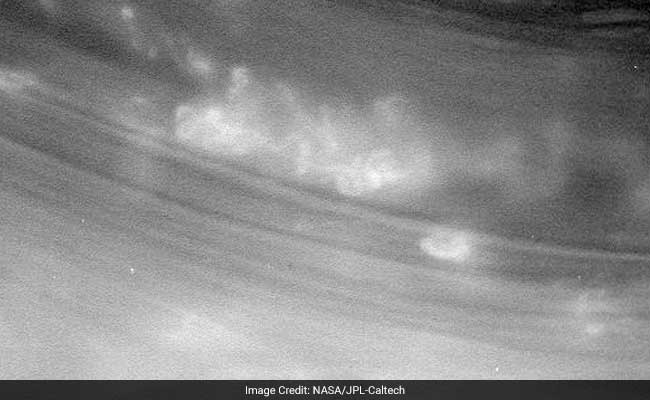
Images captured by Cassini shows features in Saturn's atmosphere from closer than ever before.
Miami:
An unmanned NASA spacecraft has survived its plunge between the rings of Saturn and, after briefly going dark for the flyby, is communicating again with Earth, the US space agency said Thursday.
Cassini skimmed closer than any previous spacecraft to the sixth planet from the Sun, and lived to tell the tale, sending back a signal that arrived early Thursday at 0656 GMT, about 20 hours after the crossing took place.
"No spacecraft has ever been this close to Saturn before. We could only rely on predictions, based on our experience with Saturn's other rings, of what we thought this gap between the rings and Saturn would be like," said Cassini project manager Earl Maize of NASA's Jet Propulsion Laboratory in Pasadena, California.
 "I am delighted to report that Cassini shot through the gap just as we planned and has come out the other side in excellent shape."
"I am delighted to report that Cassini shot through the gap just as we planned and has come out the other side in excellent shape."
The gap between the rings and the top of Saturn's atmosphere is about 1,500 miles (2,400 kilometers) wide.
The rings are made of fast-moving particles of ice and space debris that could strike and disable the spacecraft.
Cassini zipped through at a speed of about 77,000 miles per hour relative to the planet.
 The spacecraft will make a total of 22 dives between the rings and the planet before making a death plunge into the gas giant in September.
The spacecraft will make a total of 22 dives between the rings and the planet before making a death plunge into the gas giant in September.
Its next pass is scheduled for May 2.
The spacecraft is a joint mission of NASA, the European Space Agency and the Italian Space Agency. It launched in 1997 and has been orbiting Saturn since 2004.
Cassini is now running low on fuel and scientists have decided to end its mission rather than risk damaging one of Saturn's moons, whose subsurface oceans may be explored for signs of life in the future.
Cassini skimmed closer than any previous spacecraft to the sixth planet from the Sun, and lived to tell the tale, sending back a signal that arrived early Thursday at 0656 GMT, about 20 hours after the crossing took place.
"No spacecraft has ever been this close to Saturn before. We could only rely on predictions, based on our experience with Saturn's other rings, of what we thought this gap between the rings and Saturn would be like," said Cassini project manager Earl Maize of NASA's Jet Propulsion Laboratory in Pasadena, California.

Cassini Aircraft came within 3000 Km of Saturn's cloud tops and within 300 Km of its inner rings.
The gap between the rings and the top of Saturn's atmosphere is about 1,500 miles (2,400 kilometers) wide.
The rings are made of fast-moving particles of ice and space debris that could strike and disable the spacecraft.
Cassini zipped through at a speed of about 77,000 miles per hour relative to the planet.

The gap between the rings and the top of Saturn's atmosphere is about 2,000 kilometres wide.
Its next pass is scheduled for May 2.
The spacecraft is a joint mission of NASA, the European Space Agency and the Italian Space Agency. It launched in 1997 and has been orbiting Saturn since 2004.
Cassini is now running low on fuel and scientists have decided to end its mission rather than risk damaging one of Saturn's moons, whose subsurface oceans may be explored for signs of life in the future.
Track Latest News Live on NDTV.com and get news updates from India and around the world

